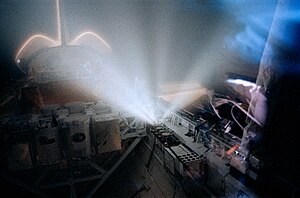
Critical ionization velocity (CIV), or critical velocity (CV), is the relative velocity between a neutral gas and plasma (an ionized gas), at which the neutral gas will start to ionize. If more energy is supplied, the velocity of the atoms or molecules will not exceed the critical ionization velocity until the gas becomes almost fully ionized.
The phenomenon was predicted by Swedish engineer and plasma scientist, Hannes Alfvén, in connection with his model on the origin of the Solar System (1942).[1][2][3] At the time, no known mechanism was available to explain the phenomenon, but the theory was subsequently demonstrated in the laboratory.[4] Subsequent research by Brenning and Axnäs (1988)[5] have suggested that a lower hybrid plasma instability is involved in transferring energy from the larger ions to electrons so that they have sufficient energy to ionize. Application of the theory to astronomy through a number of experiments have produced mixed results.[6][7]
- ^ Hannes Alfvén "On the cosmogony of the Solar System", in Stockholms Observatoriums Annaler (1942) Part I Part II Part III
- ^ Hannes Alfvén, On the Origin of the Solar System. Oxford: Clarendon Press, 1954.
- ^ Hannes Alfvén, Collision between a nonionized gas and a magnetized plasma, Rev. Mod. Phys.., vol. 32, p. 710, 1960.
- ^ U.V. Fahleson, "Experiments with plasma moving through neutral gas", Phys. Fluids, 4 123 (1961)
- ^ Brenning, N ., Axnas, I: "Critical ionization velocity interactions : Some unsolved problems", (1988) Astrophys. Space Sci. 144 15
- ^ R. Torbert,: "Review of ionospheric CIV experiments", XXVIIth COSPAR Meet., (1988) Helsinki, Finland, paper XIII.2. 1
- ^ Lai, Shu T., A review of critical ionization velocity (2001) Reviews of Geophysics, Volume 39, Issue 4, p. 471-506